Biography
Born in Cazenovia, New York, Cole attended the common schools and graduated from Union College, Schenectady, New York, in 1843. He studied law. He was admitted to the bar in 1845 and commenced practice in Chicago, Illinois. He moved to Potosi, Wisconsin the same year and continued the practice of law. He served as member of the 2nd Wisconsin Constitutional Convention in 1847.

Cazenovia is a town in Madison County, New York, United States. The population was 7,086 at the 2010 census. The town is named after Theophilus Cazenove, an agent of the Holland Land Company.

Union College is a private, non-denominational liberal arts college located in Schenectady, New York. Founded in 1795, it was the first institution of higher learning chartered by the New York State Board of Regents. In the 19th century, it became the "Mother of Fraternities", as three of the earliest such organizations were established there. After 175 years as a traditional all-male institution, Union College began enrolling women in 1970.
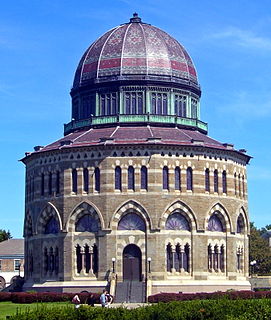
Schenectady is a city in Schenectady County, New York, United States, of which it is the county seat. As of the 2010 census, the city had a population of 66,135. The name "Schenectady" is derived from a Mohawk word, skahnéhtati, meaning "beyond the pines". Schenectady was founded on the south side of the Mohawk River by Dutch colonists in the 17th century, many from the Albany area. They were prohibited from the fur trade by the Albany monopoly, which kept its control after the English takeover in 1664. Residents of the new village developed farms on strip plots along the river.
In 1848, Cole was elected as a Whig to the U.S. House of Representatives, representing Wisconsin's 2nd congressional district. In Congress, he sided with the anti-slavery Whigs and refused to support the fugitive slave provisions of the Compromise of 1850. He ran for re-election in 1850, but was defeated by Democrat Ben C. Eastman.

The Whig Party was a political party active in the middle of the 19th century in the United States. Four presidents belonged to the party while in office. It emerged in the 1830s as the leading opponent of Jacksonian democracy, pulling together former members of the National Republican and the Anti-Masonic Party. It had some links to the upscale traditions of the long-defunct Federalist Party. Along with the rival Democratic Party, it was central to the Second Party System from the early 1840s to the mid-1860s. It originally formed in opposition to the policies of President Andrew Jackson and his Democratic Party. It became a formal party within his second term, and slowly receded influence after 1854. In particular terms, the Whigs supported the supremacy of Congress over the presidency and favored a program of modernization, banking and economic protectionism to stimulate manufacturing. It appealed to entrepreneurs, planters, reformers and the emerging urban middle class, but had little appeal to farmers or unskilled workers. It included many active Protestants and voiced a moralistic opposition to the Jacksonian Indian removal. Party founders chose the "Whig" name to echo the American Whigs of the 18th century who fought for independence. The political philosophy of the American Whig Party was not related to the British Whig party. Historian Frank Towers has specified a deep ideological divide:

Wisconsin's 2nd congressional district is a congressional district of the United States House of Representatives in southern Wisconsin, covering Dane County, Iowa County, Lafayette County, Sauk County and Green County, as well as portions of Richland County and Rock County. The district includes Madison, the state's capital, its suburbs and some of the surrounding areas.

The Fugitive Slave Act or Fugitive Slave Law was passed by the United States Congress on September 18, 1850, as part of the Compromise of 1850 between Southern slave-holding interests and Northern Free-Soilers.
He resumed the practice of law in Potosi until 1855, when he was elected to the Wisconsin Supreme Court, largely because of his opposition to the fugitive slave laws. In November 1880, Cole was appointed by Governor William E. Smith to fill the vacant Chief Justice role created by the death of Justice Edward George Ryan. He was elected to a full term as Chief Justice in April 1881.

William E. Smith was a merchant and politician in Wisconsin. He was a member of the Wisconsin State Senate and served as the 14th Governor of Wisconsin.

Edward George Ryan was an American jurist and the 3rd chief justice of the Wisconsin Supreme Court.
At the end of his term in 1892, he retired to Milwaukee, Wisconsin, where he died on May 5, 1903.He was interred in Forest Hill Cemetery, in Madison, Wisconsin.

Madison is the capital of the U.S. state of Wisconsin and the seat of Dane County. As of July 1, 2017, Madison's estimated population of 255,214 made it the second-largest city in Wisconsin by population, after Milwaukee, and the 82nd-largest in the United States. The city forms the core of the Madison Metropolitan Area which includes Dane County and neighboring Iowa, Green, and Columbia counties for a population of 654,230.
His former home, now known as the Carrie Pierce House, is listed on the National Register of Historic Places. [3] [4]

The Carrie Pierce House is a historic house in Madison, Wisconsin, United States that is listed on the National Register of Historic Places

The National Register of Historic Places (NRHP) is the United States federal government's official list of districts, sites, buildings, structures, and objects deemed worthy of preservation for their historical significance. A property listed in the National Register, or located within a National Register Historic District, may qualify for tax incentives derived from the total value of expenses incurred preserving the property.
He married his first wife Julia A. Houghton in 1848. They had two children, Sidney, who lived to adulthood, and Orasmus, who died as an infant in 1853. Julia died in 1874. He married his second wife, Roberta C. Noe Garnhart, the widow of John H. Garnhart, on January 1, 1879, at Madison, Wisconsin. She died June 17, 1884.
This page is based on this
Wikipedia article Text is available under the
CC BY-SA 4.0 license; additional terms may apply.
Images, videos and audio are available under their respective licenses.
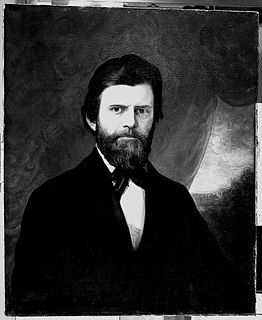
Nelson Dewey was an American politician from the U.S. state of Wisconsin who served as the first Governor of Wisconsin.

Thomas George Pratt was a lawyer and politician from Annapolis, Maryland. He was the 27th governor of Maryland from 1845 to 1848 and a U.S. senator from 1850 to 1857.

The fugitive slave laws were laws passed by the United States Congress in 1793 and 1850 to provide for the return of slaves who escaped from one state into another state or territory. The idea of the fugitive slave law was derived from the Fugitive Slave Clause which is in the United States Constitution. It was thought that forcing states to deliver escaped slaves to slave owners violated states' rights due to state sovereignty and was believed that seizing state property should not be left up to the states. The Fugitive Slave Clause states that escaped slaves "shall be delivered up on Claim of the Party to whom such Service or Labour may be due", which abridged state rights because retrieving slaves was a form of retrieving private property. The Compromise of 1850 entailed a series of laws that allowed slavery in the new territories and forced officials in Free States to give a hearing to slaveholders without a jury.

Timothy Otis Howe was a member of the United States Senate, representing the state of Wisconsin from March 4, 1861 to March 3, 1879. He also served as U.S. Postmaster General from 1881 until his death in 1883.

Serranus Clinton Hastings was a 19th-century politician, rancher and a prominent lawyer in the United States. He studied law as a young man and moved to the Iowa District in 1837 to open a law office. Iowa became a territory a year later, and he was elected a member of the House of Representatives of the Iowa Territorial General Assembly. When the territory became the state of Iowa in 1846, he won an election to represent the state in the United States House of Representatives. After his term ended, he became Chief Justice of the Iowa Supreme Court. He resigned after one year in office and moved to California. He was appointed to the California Supreme Court as Chief Justice a few months later. He won an election to be Attorney General of California, and assumed office shortly after his term as Chief Justice ended. He began practicing law again as Attorney General. He earned a small fortune with his law practice and used that fortune to finance his successful real estate venture. In 1878, he founded the Hastings College of the Law with a donation of US$100,000.
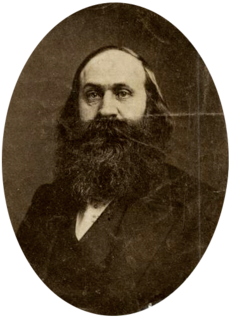
Sherman Miller Booth was an abolitionist, editor and politician in Wisconsin, and was instrumental in forming the Liberty Party, the Free Soil Party and the Republican Party. He became known nationally after helping instigate a jailbreak for a runaway slave in violation of the Fugitive Slave Act.

Andrew Galbraith Miller was an associate justice of the territorial Wisconsin Supreme Court and later a United States federal judge.
William Hebard was an attorney and politician from Vermont. He served in several elected offices, and was most notable for representing Vermont in the United States House of Representatives for two terms (1849-1853).
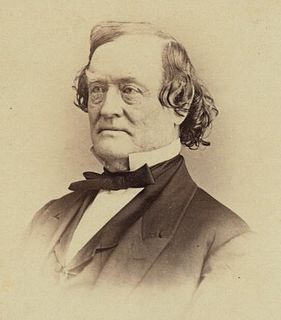
Rufus Paine Spalding was a nineteenth-century politician, lawyer and judge from Ohio.
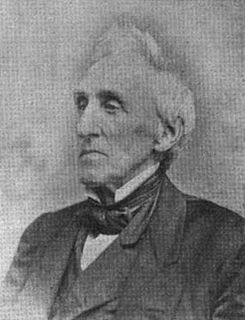
Thomas Belden Butler was a Whig politician from Connecticut. He was Chief Justice of the Connecticut Supreme Court from 1870 to 1873. He was a member of the United States House of Representatives from Connecticut's 4th congressional district from 1849 to 1851. He had previously served as a member of the Connecticut Senate representing the 12th District from 1847 to 1848. In 1848, he was President pro tempore of the Connecticut Senate. He also had served as a member of the Connecticut House of Representatives from 1832 to 1834, from 1837 to 1838, from 1843 to 1844, and from 1846 to 1847.

Edward Wilson McGaughey was a U.S. Representative from Indiana.

Mason Cook Darling was a U.S. Representative from Wisconsin.

The presidency of Millard Fillmore began on July 9, 1850, when Millard Fillmore became President of the United States upon the death of Zachary Taylor, and ended on March 4, 1853. Fillmore had been Vice President of the United States for 1 year, 4 months when he became the 13th United States president. Fillmore was the second president to succeed to the office without being elected to it, after John Tyler, as well as the last Whig president. Fillmore was succeeded by Democrat Franklin Pierce.

Harlow South Orton was an American lawyer and legislator from Wisconsin who served as a member of the Wisconsin Supreme Court from 1878 to 1895, and chief justice for 1894-95. He is chiefly remembered as the author of Vosburg v. Putney (1890).

John McLean was an American jurist and politician who served in the United States Congress, as U.S. Postmaster General, and as a justice of the Ohio and U.S. Supreme Courts. He was often discussed for the Whig and Republican nominations for President.

Samuel Nelson was an American attorney and appointed as judge of New York State courts. He was appointed as a Justice of the Supreme Court of the United States, serving from 1845 to 1872. He concurred on the 1857 Dred Scott decision, although for reasons different from Chief Justice Taney's.
Robert George Siebecker was an American judge and the 9th Chief Justice of the Wisconsin Supreme Court.

Edward Vernon Whiton was an American lawyer and jurist, and was the first Chief Justice of the Wisconsin Supreme Court.





























